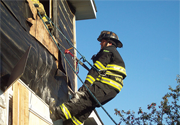| |
| |
 |
 |
| |
 |
|
@{mv_date_MMM d, yyyy}@ |
|
| |
A new survey released by the Canadian Association of Fire Chiefs (CAFC) details the realities Canada’s 3,200 fire departments are facing.
» Read more
A new pilot program is creating teams of counsellors and paramedics to reach out to people suffering from addictions in Saskatchewan’s two largest cities and offer them support.
» Read more
Quebec’s Kativik regional government has a goal of making sure every Nunavik community has a certified firefighter instructor and new and improved fire halls.
» Read more
Additional resources for B.C.’s increasingly strained Nanaimo Fire Rescue (NFR) appear likely following a commitment from city councillors. Unanimous preliminary approval during a finance and audit committee meeting last week would see 40 new firefighters hired, including 20 next year.
» Read more
|
| |
|
| |

Acclaimed cartoonist, illustrator and veteran firefighter Paul Combs has returned with a brand new collection of his fire service editorials!
Paul sees and captures moments that help us all take a good look at ourselves and learn from it. He does it as no one else can—with humor, irreverence, respect, insight, compassion, and the skills of an award-winning illustrator.
This beautiful full-colour hardcover edition is now available from Firehall Bookstore.
» Order your copy today! |
| |
|
| |
 When needing to escape from the upper floors of a structure, using a rope bailout system may be an option to look at. The headfirst ladder dive was explored in our last issue as one way to do this, but if there is no ladder in place, what else can you do? In Canada, this tactical option is not a popular one, with many departments shying away from this tactic and adopting the hose line bailout instead. By Mark van der Feyst.
» Read more
When needing to escape from the upper floors of a structure, using a rope bailout system may be an option to look at. The headfirst ladder dive was explored in our last issue as one way to do this, but if there is no ladder in place, what else can you do? In Canada, this tactical option is not a popular one, with many departments shying away from this tactic and adopting the hose line bailout instead. By Mark van der Feyst.
» Read more |
| |
 The Winnipeg Fire Paramedic Service launched its Diversity and Equity Fire Training program in 2021 to reduce barriers facing prospective firefighters. Currently, the closest place to complete Firefighter I and II training is at Brandon’s Manitoba Emergency Service College (MESC). It takes nine months, is full-time and in person, and costs about $30,000 for tuition and room and board. With the launch of this new program, WFPS Chief Schmidt hopes to reduce systemic barriers for prospective firefighters and see more diverse candidates apply for firefighting jobs. By Winnipeg Fire Paramedic Service.
» Read more
The Winnipeg Fire Paramedic Service launched its Diversity and Equity Fire Training program in 2021 to reduce barriers facing prospective firefighters. Currently, the closest place to complete Firefighter I and II training is at Brandon’s Manitoba Emergency Service College (MESC). It takes nine months, is full-time and in person, and costs about $30,000 for tuition and room and board. With the launch of this new program, WFPS Chief Schmidt hopes to reduce systemic barriers for prospective firefighters and see more diverse candidates apply for firefighting jobs. By Winnipeg Fire Paramedic Service.
» Read more |
| |
|
| |
The role of the training officer is one of the most critical and influential roles within the fire service. Training is what bonds our fire departments; it is what draws in new talent and keeps veterans excited and engaged. The role is so essential that morale and the organization can crumble without a good training officer. By Arjuna George.
» Read more
|
|
The COVID-19 pandemic has exacerbated cases of cardiovascular disease by disrupting much-needed care, screening and research, shows a report released in October by the Heart and Stroke Foundation of Canada (Heart & Stroke). Considering that NFPA research shows that sudden cardiac death is the leading cause of on-duty deaths among firefighters, this new research from the foundation is troubling. By Julie Fitz-Gerald.
» Read more
| | |
| FIRE FIGHTING IN CANADA: THE PODCAST |
|
|
| |
|
In the latest edition of Fire Fighting in Canada: The Podcast, Fire Chief Tom DeSorcy sat down with Craig Richardson, a training specialist and fire services advisor with the Office of the Fire Commissioner in B.C., to talk about training standards. The two discussed the 2014 training Playbook and how it helped to revolutionize training standards in B.C. Tune in to hear where training is headed now with the OFC’s training standard, what’s changing and how departments are reacting.
» Listen now |
| |
|
| |
|
|
| |
| |





